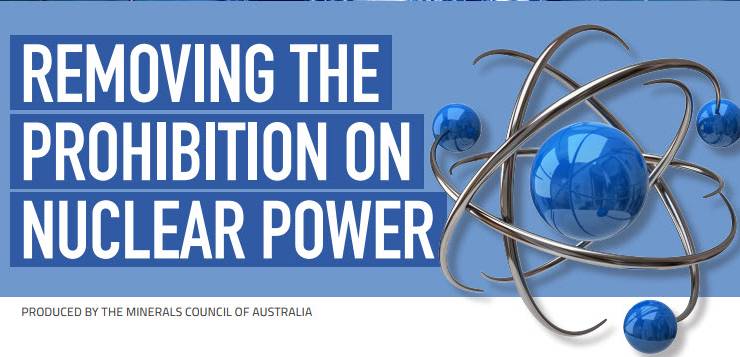
Fans of nuclear power might have got excited this morning when they read that the Minerals Council of Australia had produced an “analysis” on how it was time to end the prohibition on nuclear power plants in Australia.
“Analysis” calls to mind a sober assessment of the pros and cons, some consideration of evidence, an exploration of issues commonly raised on a subject, but alas, the “analysis” or, as it’s termed, “policy paper” from the Minerals Council is more like a brochure.
As always, we went immediately to the (short) bit about the costs of nuclear power, given the long history of nuclear power plants running hundreds of per cent and decades over budget and schedule. According to the Minerals Council’s “policy paper”:
“Nuclear power is affordable. All baseload power projects are capital intensive, but countries that invest in nuclear plants – and there are 58 reactors under construction today – will have assets that generate large amounts of power for 60 years at a stable cost.”
One has to feel a little sad for the MCA that between the presumed finalisation of this “policy paper” and today, there have been some unhappy developments. That “58” figure is based on the International Atomic Energy Association’s list (which is actually 57, but that’s OK), which includes two reactors under construction in the United States. But that is likely soon to be zero reactors under construction in the United States. At the start of August, one of the projects shut down: the VC Summer power plant in South Carolina,, which was already 35% built, will be abandoned. And two days later, the firm building the Vogtle project in Georgia admitted (another) blowout in the cost — to $25.7 billion for two reactors.
The original Vogtle cost was projected to be $14 billion, as Fox News helpfully pointed out, so the near-doubling of the budget isn’t actually too bad by nuclear standards. The usual delay in the project, by at least two years, was also announced. There’s a widespread expectation Vogtle will now be cancelled as well. But the cost blowouts at the two projects were so massive, they bankrupted nuclear reactor company Westinghouse Electric earlier this year. And on Wednesday, a Florida energy company abandoned plans for a new nuclear power plant in that state and will instead invest in a massive new solar plant and battery storage.
In July, the company charged with building the proposed Hinkley Point nuclear power plant in the UK revealed the cost had blown out from £18 billion to£20.3 billion and would be delayed by 15 months. The British Audit Office has warned the final cost may well be £50 billion.
And in case you think cost blowouts and project delays are purely a result of NIMBY Westerners and extreme environmental red tape, China, which is engaged in a substantial ramp-up of its nuclear reactor capacity and doesn’t have to worry about pesky things like community opposition or the rule of law, has also encountered multi-year delays.
Sadly none of this made it into the Minerals Council’s brochure. You might think that’s simply because it wants to mindlessly spruik the interests of the uranium mining industry, but we would never accuse the MCA of such a thing.








Good link to the Chinese nuclear program.
Supporting a nuclear industry (power or submarines) requires very deep engineering manufacturing experience. It would take Australia at least a decade of funded activity to reach that.
BTW. The pommy project is contracted to supply power to the grid at $90 per MW/Hr.
The latest European wind farm project, built without subsidy, is $9 per MW/Hr.
Yeah! yeah! The wind does not blow all the time. In one place that is, it’s always blowing somewhere. If not in Victoria then in Queensland or South Australia, a proper interconnector is required. And pumped storage is a no brainer, plenty of suitable locations have already been identified. Get on with it for God/Allah’s sake, and ours.
Talkbull spouting on endlessly about “snowy 2 ” as though it was a done deal when ALL that has been done is agree to a study into the possibility. Then someday when there is an oil lamp and candle shortage something should be done, gives me the shirts. Again how come the news media don’t pick up on this sort of drivel? Damn I’ve got the shirts again- gotta go.
Of course there’s nothing in a nuclear plant that can go wrong (click) go wrong (click) go wrong (click) go wrong …. the weakest point in the advocacy by the enthusiasts who sense a career opening for themselves in switching to nuclear power is the lack of any commitment to public risk insurance. If there is any accidental leakage of radio-isotopes into the environment it’s us plebs who are expected to foot the bill. When the “100% saf71e” Fukushima plant went ape, it was Japan’s “common herd”, not the suppliers, who had to leave their nearby homes and farms for ever, and it’s Japan’s taxpayers who have to foot the bill for coping with the ongoing damage. Let the nuke-heads show how they’ll put their money where their mouths are.
One major problem of nuclear power plant is never mentioned. A concentration of power in one place for a huge area. Easy for a saboteur,bomb to knock out that huge footprint with one king hit.
Power generation should be small scale and local. Why shouldn’t my suburb of Sydney have it’s own solar or windpower plant with back up batteries